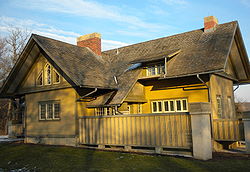Fabyan Villa
|
Fabyan Villa
|
|
 |
|
| Location | Geneva, Illinois |
|---|---|
| Coordinates | 41°52′16″N 88°18′43″W / 41.87111°N 88.31194°WCoordinates: 41°52′16″N 88°18′43″W / 41.87111°N 88.31194°W |
| Built | 1907 |
| Architect | Frank Lloyd Wright |
| Architectural style | Prairie School |
| NRHP Reference # | 84001128 |
| Added to NRHP | February 9, 1984 |
Fabyan Villa was the home of George and Nelle Fabyan from c. 1908 to 1939. The house is notable because of its remodelling in 1907 by Frank Lloyd Wright. It was the centerpiece of the Fabyans country estate, which they named Riverbank. The Kane County Forest Preserve District of Illinois purchased the majority of the Fabyan estate in 1939, and operated the Fabyan's home as a museum off and on beginning in 1940. In 1995 Preservation Partners of the Fox Valley was enlisted to operate the site and developed the Fabyan Villa Museum into a Fabyan historic home museum, where photographs, the Fabyans' personal artifact collections, and a limited number of original furnishings, as well as the Riverbank story are shared with the public.
George Fabyan was a millionaire businessman who had a thirst for knowledge. Inheritance from his tycoon-father's textile business, Bliss, Fabyan & Co. provided the financial foundation from which the Colonel and his wife, Nelle, established their legacy. Riverbank, their estate on the Fox River in Geneva, Illinois spanned approximately 300 acres (1.2 km2) and featured, among other things, a Japanese Garden, private zoo, Roman-style swimming pool, greenhouses, gardens, grottoes, a lighthouse, a Dutch-style windmill, a country club, a small farm and a scientific laboratory complex.
The mid-1800s farmhouse that the Fabyans acquired in 1905 was dubbed by them, The Villa. In 1907, the farmhouse was extensively redesigned by Wright, who added a south wing, three verandas, and large eaves to achieve a cruciform modestly Prairie-style country house. Other hallmarks of Wright's organic architecture found in the Fabyan Villa are geometric window motifs, 'light screens' (bands of windows), string-coursing, open floor plan, and wood-spindle screening.
In 1910, the Fabyans hired Taro Otsuka to design a Japanese-style garden below the villa. The one-acre garden was developed over the next several years, and from 1918 on, maintained by Susumu Kobayashi, a Japanese immigrant gardener. Japanese gardens were popular amongst the upper class, and it was a well-known attraction throughout the 1920s and 1930s. Although neglected for decades after the Fabyans, the Fabyan Japanese Garden was renovated beginning in 1974, and today contains restored and replicated original elements including a pond, waterfall, moon bridge, oversized lantern, and teahouse.
...
Wikipedia

